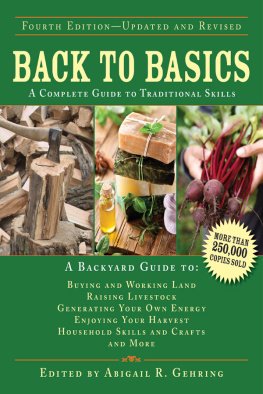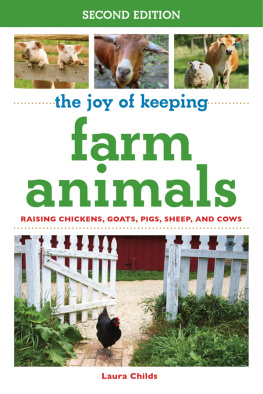The
Home Farm


The
Home Farm
How to grow your own fruit and vegetables and keep animals and bees in your backyard

Nicki Trench


This edition published in 2022 by CICO Books An imprint of Ryland Peters & Small Ltd
| 2021 Jockeys Fields | 341 E 116th St |
| London WC1R 4BW | New York, NY 10029 |
First published in 2010 as Creating Your Backyard Farm and Creating your Garden Farm
www.rylandpeters.com
10 9 8 7 6 5 4 3 2 1
Text Nicki Trench 2010 and 2021
Design, illustration, and photography CICO Books 2010
The authors moral rights have been asserted. All rights reserved. No part of this publication may be reproduced, stored in a retrieval system, or transmitted in any form or by any means, electronic, mechanical, photocopying, or otherwise, without the prior permission of the publisher.
A CIP catalog record for this book is available from the Library of Congress and the British Library.
ISBN: 978-1-80065-092-3
E-ISBN: 978-1-80065-146-3
Printed in China
Project Editor: Gillian Haslam
Text editor: Jo Richardson
Designer: Christine Wood
Photographer: David Merewether
(photographs on page 71, 75, 76, 79, 87, 108, 111 and 133, step 6 by Caroline Hughes)
Illustrator: Michael Hill
Art director: Sally Powell
Head of production: Patricia Harrington
Publishing manager: Penny Craig
Publisher: Cindy Richards

Introduction
The enthusiasm for growing your own produce and cooking fresh and local extends much further than simply reducing costs. People are feeling tricked; we no longer recognize the true shapes, colors, and textures of the plastic-wrapped and overpackaged produce that appears on the shelves of our supermarkets. Were presented with a world removed from reality. Headless, footless, and fatless chickens encased in cellophane; apples, carrots, and tomatoes all uniform in shape and color; broccoli trimmed and wrapped so perfectly that no one knows what the real plant looks like. When you grow your own produce, you see the plant for how it isthe beautiful deep-red veins that run through beet (beetroot) leaves, strangely shaped carrots unlike the straight, uniform specimens you see in the stores, or the majestic thistlelike flower of the artichoke.
Embracing the oddball
People now reject odd-shaped vegetables because they probably think theyre from outer space. With all this perfection around in the kitchen, maybe we apply the same weird standards to people, rejecting the apparently odd from our lives. The world of advertising has a lot to answer for. And how many children can name the various vegetables when they see them, let alone recognize the plant, or know where cuts of meat come from?
Making a change for the better
With the growing awareness of the impact that food miles has on the environment and the advantages of eating nonsprayed, local, and organic food, people are once more opting to grow their own. In the U.S., the sales of vegetable seeds have now overtaken those of flowers and hen husbandry is outstripping the keeping of rabbits and guinea pigs as pets. Of course, this all makes sense. Domestic pets have their uses: cats are great mouse and rat catchers, and dogs will keep unwelcome cats off the fresh soil in your vegetable patch. But nothing is as good and tasty as a bright yellow egg produced by your own free-range, happy hens.

Fresh eggs with bright yellow yolks laid daily by your own hens.
Using your time and space wisely
The space you have will determine just how far you go in being a home farmer. If you have a small backyard (garden), with room for only a few pots, this shouldnt put you off. You can grow a wide variety of vegetables and fruits in a small space and many varieties will enthusiastically grow wonderful produce. If you have a larger space, plan carefully and youll be able to have enough beds to rotate your crops, helping to maintain their health and that of the soil, as well as the opportunity to keep hens, bees, or even goats and pigs. And that means youll be well on the way to being self-sufficient.

Ripe, crunchy apples waiting to be picked and eaten straight from the tree.
Animals will need time devoted to them, and they also need to be kept in an appropriate area that is best for them and best for you. I once kept a goat and decided to let it have free run of the garden, until it ate through my internet cable. It has to work both ways: an escaped pig may be fun to watch being chased back to its pen by amused bystanders, but it can totally destroy your vegetables in two minutes flat.
In our modern society, time is an issue. Most people simply cannot devote their whole time to becoming totally self-sufficient, but even if you make just a small impact on your own and your familys lives, you will be contributing to the good of the environment and your and their well-being. There may be times of the year when your home-grown produce will be sparse, but with a little planning, you should be able to grow at least something for the kitchen table in every season, and can and preserve your gluts to keep you going through winter
Benefiting your health
Spending time in your garden has enormous health benefits. Not only will you be working outside in the fresh air but digging and preparing your soil, weeding, and turning over your compost will render visits to the gym unnecessary. Who wants to waste time on a treadmill when you could be working toward growing and producing your own food instead? In recent years many local communities have set up community gardens (allotments) where theyre finding that working with the soil, besides offering enormous physical health benefits, gives people a sense of purpose and improves mental health.
Vegetables are best eaten fresh, as they contain natural sugars that quickly turn to starch. Commercially grown vegetables have often lost a great deal of their goodness by the time they reach the supermarket shelves and, whats more, have lost half their flavor. As soon as you start to harvest and eat your own produce, youll be bowled over by the explosion of flavors that makes store-bought produce fade into insignificance.




















